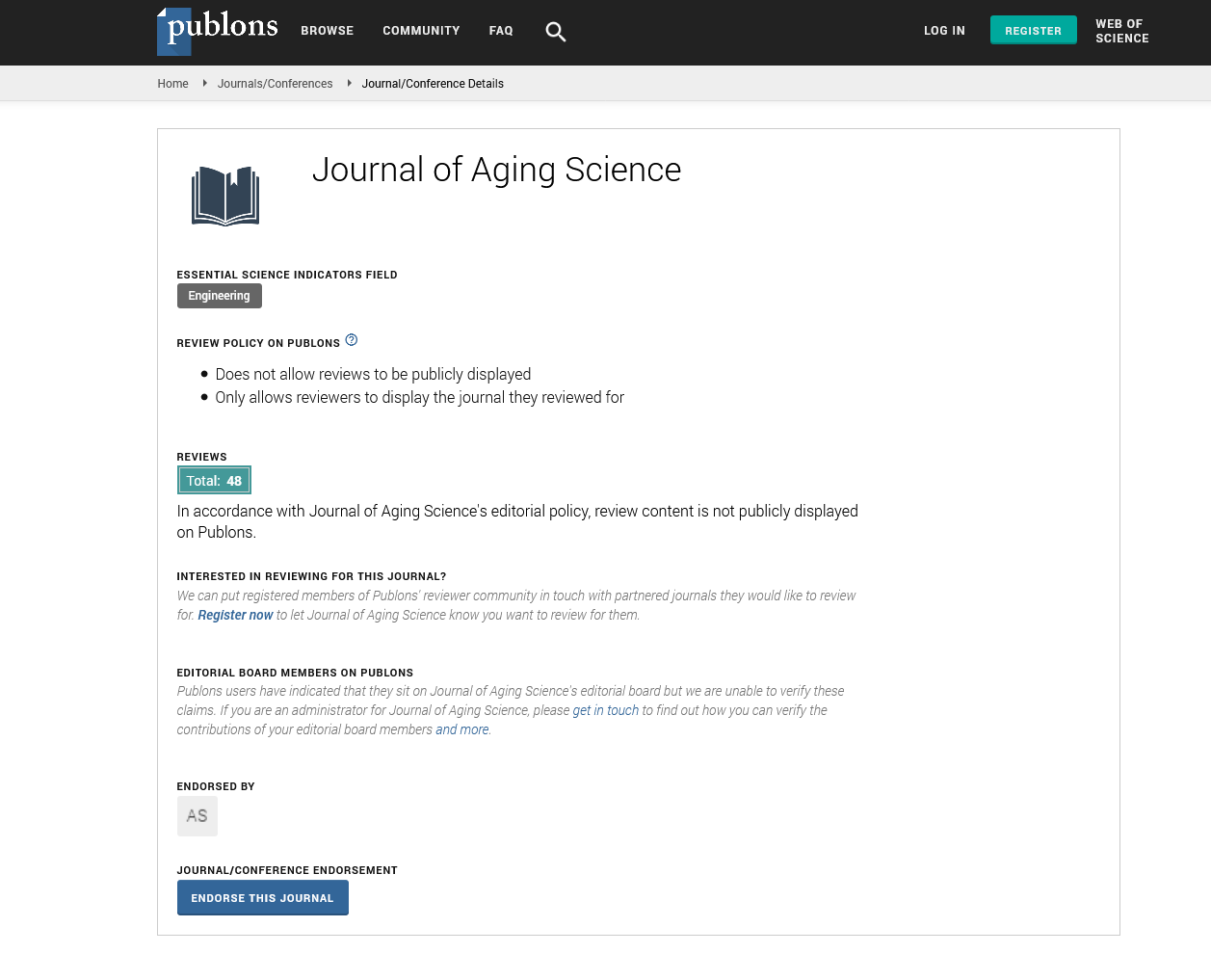Indexed In
- Open J Gate
- Academic Keys
- JournalTOCs
- ResearchBible
- RefSeek
- Hamdard University
- EBSCO A-Z
- OCLC- WorldCat
- Publons
- Geneva Foundation for Medical Education and Research
- Euro Pub
- Google Scholar
Useful Links
Share This Page
Journal Flyer

Open Access Journals
- Agri and Aquaculture
- Biochemistry
- Bioinformatics & Systems Biology
- Business & Management
- Chemistry
- Clinical Sciences
- Engineering
- Food & Nutrition
- General Science
- Genetics & Molecular Biology
- Immunology & Microbiology
- Medical Sciences
- Neuroscience & Psychology
- Nursing & Health Care
- Pharmaceutical Sciences
Short Communication - (2025) Volume 13, Issue 3
Cellular Senescence and Human Aging: Mechanisms, Consequences and Potential Interventions
John Wilkins*Received: 30-Jun-2025, Manuscript No. JASC-25-29562; Editor assigned: 03-Jul-2025, Pre QC No. JASC-25-29562 (PQ); Reviewed: 17-Jul-2025, QC No. JASC-25-29562; Revised: 24-Jul-2025, Manuscript No. JASC-25-29562 (R); Published: 31-Jul-2025, DOI: 10.35248/2329-8847.25.13.424
Description
Aging is a gradual process influenced by a variety of biological mechanisms, among which cellular senescence has drawn significant attention. Cellular senescence is a state in which cells stop dividing but remain metabolically active. Unlike healthy dividing cells, senescent cells exhibit changes in function, morphology and secretory patterns. This phenomenon is believed to be both protective and detrimental, depending on its context and accumulation within tissues.
Initially, cellular senescence serves as a defense mechanism. Cells that experience DNA damage, oxidative stress, or oncogenic signals often enter senescence to prevent uncontrolled growth and the potential formation of tumors. In this regard, senescence acts as a safeguard for maintaining genomic stability. However, as individuals age, senescent cells accumulate in multiple tissues and their prolonged presence contributes to physiological decline [1-3].
One of the defining features of senescent cells is the Senescence- Associated Secretory Phenotype (SASP). These cells release pro-inflammatory cytokines, growth factors and proteases into the surrounding environment. While the SASP can stimulate tissue repair in short-term situations, chronic exposure leads to inflammation, tissue remodeling and disruption of normal cellular communication. This persistent inflammatory state, often linked with age-related diseases, creates an imbalance in tissue microenvironments.
Senescence is not uniform across all tissues. Different organs accumulate senescent cells at different rates, depending on their regenerative capacity, exposure to stress and genetic factors [4]. For example, the skin and immune system often show visible signs of aging earlier than internal organs. Accumulation of senescent fibroblasts in skin contributes to wrinkles and reduced elasticity, while senescent immune cells weaken the ability to respond effectively to infections. Similarly, in the cardiovascular system, endothelial senescence contributes to reduced vascular function and the development of atherosclerotic plaques [5].
The link between senescence and age-related diseases has become increasingly clear. Conditions such as osteoarthritis, type 2 diabetes, Alzheimer’s disease and pulmonary fibrosis have all been associated with an excessive burden of senescent cells. This observation has fueled research into strategies for modulating senescence, either by preventing its onset or by eliminating existing senescent cells [6].
Recent advances in biomedical research have introduced the concept of senolytics, which are compounds that selectively target and remove senescent cells. Preclinical studies in animal models have shown that clearing senescent cells can extend lifespan, improve tissue function and reduce the severity of age-associated disorders [7]. Other approaches, such as senomorphics, aim to suppress the harmful effects of the SASP without killing the cells. These approaches suggest that manipulating senescence could significantly impact healthspan and longevity.
Lifestyle and environmental factors also influence the rate at which senescence develops. Regular exercise, a balanced diet and reduced exposure to toxins have been linked with lower levels of senescence-related markers. Caloric restriction and intermittent fasting, for instance, have been shown to delay senescence in animal studies, possibly through pathways related to oxidative stress and DNA repair. Although translating these findings into human health remains complex, they highlight the connection between lifestyle and cellular aging [8-10].
Furthermore, senescence is now understood to play a role in tissue regeneration and wound healing. In acute injury, the temporary appearance of senescent cells supports repair processes by recruiting immune cells and stimulating nearby tissue responses. This dual role—beneficial in the short term and harmful when chronic—underscores the complexity of targeting senescence therapeutically.
The study of cellular senescence continues to expand, intersecting with genetics, immunology and regenerative medicine. By understanding the molecular pathways involved such as p53, p16INK4a and mTOR researchers aim to design targeted interventions that control senescence without impairing its protective benefits.
Conclusion
Cellular senescence represents both a safeguard and a burden in the biology of aging. While it protects against tumorigenesis and aids in wound healing, the accumulation of senescent cells contributes to tissue dysfunction and the onset of age-related conditions. Research on senescence has opened new directions in aging science, particularly with the development of senolytics and senomorphics that may delay or even reverse aspects of physiological decline.
Understanding the dual role of senescence highlights the delicate balance within biological systems. The challenge ahead lies in harnessing the protective benefits of senescence while minimizing its long-term detrimental effects. Advances in molecular biology, pharmacology and lifestyle research suggest that strategies targeting senescence could play a central role in promoting healthy aging. As investigations progress, the study of cellular senescence is likely to remain a key focus in the broader effort to extend healthspan and improve quality of life in older populations.
References
- Herranz N, Gil J. Mechanisms and functions of cellular senescence. J Clin Invest. 2018;128(4):1238-1246.
- Ogrodnik M. Cellular aging beyond cellular senescence: Markers of senescence prior to cell cycle arrest in vitro and in vivo. Aging Cell. 2021;20(4):e13338.
[Crossref] [Google Scholar] [PubMed]
- Campisi J. The role of cellular senescence in skin aging. J Investig Dermatol Symp Proc 1998;3(1):1-5.
[Crossref] [Google Scholar] [PubMed]
- Ohtani N, Mann DJ, Hara E. Cellular senescence: its role in tumor suppression and aging. Cancer Sci. 2009;100(5):792-797.
[Crossref] [Google Scholar] [PubMed]
- Chin T, Lee Y, Dreesen O. The role of cellular senescence in skin aging and age-related skin pathologies. Front Physiol. 2023;14:1297637.
[Crossref] [Google Scholar] [PubMed]
- Grimes A, Chandra SB. Significance of cellular senescence in aging and cancer. Cancer Res Treat.2009;41(4):187-195.
[Crossref] [Google Scholar] [PubMed]
- Kowald A, Passos JF, Kirkwood TB. On the evolution of cellular senescence. Aging Cell. 2020;19(12):e13270.
[Crossref] [Google Scholar] [PubMed]
- Muñoz-Espín D, Serrano M. Cellular senescence: from physiology to pathology. Nat Rev Mol Cell Biol. 2014;15(7):482-496.
[Crossref] [Google Scholar] [PubMed]
- Khosla S, Farr JN, Tchkonia T, Kirkland JL. The role of cellular senescence in ageing and endocrine disease. Nat Rev Endocrinol. 2020;16(5):263-275.
[Crossref] [Google Scholar] [PubMed]
- Roger L, Tomas F, Gire V. Mechanisms and regulation of cellular senescence. Int J Mol Sci. 2021;22(23):13173.
[Crossref] [Google Scholar] [PubMed]
Citation: Wilkins J (2025). Cellular Senescence and Human Aging: Mechanisms, Consequences and Potential Interventions. J Aging Sci. 13:424.
Copyright: © 2025 Wilkins J. This is an open-access article distributed under the terms of the Creative Commons Attribution License, which permits unrestricted use, distribution and reproduction in any medium, provided the original author and source are credited.

